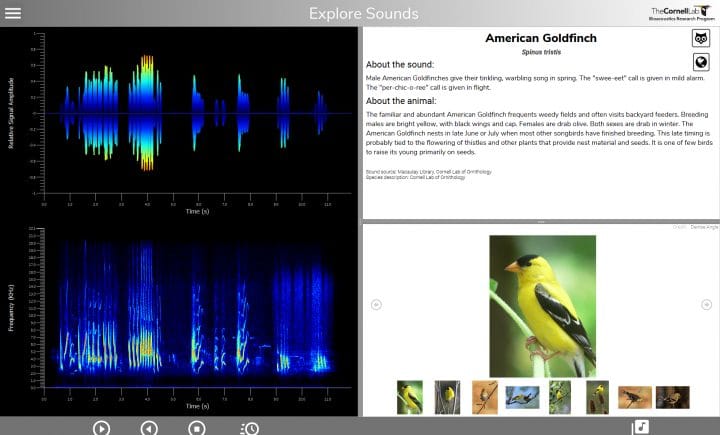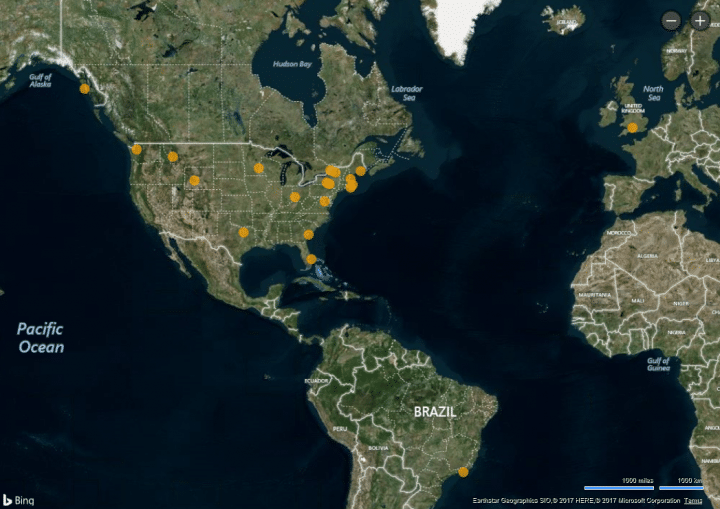Raven Exhibit
Raven Exhibit is a sound visualization and recording system optimized for public displays and exhibits in places like science museums, zoos, aquariums, and nature centers.
The new Raven Exhibit connects users worldwide with support for content in English, Portuguese, Spanish, German, and French. Added video display and touch screen compatibility creates an engaging experience for audiences to enjoy the fascinating world of animal sounds. Users can not only listen to the songs and calls of a species, they can also learn about species-specific vocal behavior. This capability aids in deeper understanding and retention of bird vocalization and acoustic behavior.
Images and sounds for most of the content is from the extensive collections at the Macaulay Library.
Features
 Raven Exhibit is an interactive sound visualization and information display portal optimized for public outreach, exhibits, training, and educational applications in science museums, zoos, aquariums, and nature centers. The software platform offers the experience of animal sound and behavior to the users in a unique format that incorporates a lesson on the properties of sound, opportunities for game play and competition, natural history information, and a variety of species-specific information.
Raven Exhibit is an interactive sound visualization and information display portal optimized for public outreach, exhibits, training, and educational applications in science museums, zoos, aquariums, and nature centers. The software platform offers the experience of animal sound and behavior to the users in a unique format that incorporates a lesson on the properties of sound, opportunities for game play and competition, natural history information, and a variety of species-specific information.
Raven Exhibit provides visitors, students, content managers, and trainers with a variety of interactive experiences ranging from immersive to informative and entertaining based on how a hosting organization chooses to configure it. The software platform offers flexibility to fit the needs of hosting organizations. A typical installation requires a computer with monitor, speakers, microphone with preamp, Raven Exhibit software, and sound contents. The user interfaces are simple and effective, with a wide range of customization options, making this exhibit one that visitors of all ages can interact with.
all ages can interact with.
Currently, there are more than 20 major installations of Raven Exhibits around the world, including an installation at the Cornell Lab of Ornithology Visitor Center. The Sound Studio, featuring Raven Exhibit software is a popular visitor destination at the Johnson Center for Birds and Biodiversity (home of the Cornell Lab of Ornithology). One of the most recent exhibits is at Ithaca Science center where the exhibit is installed inside a fabricated tree trunk. Reviewed and praised by exhibit evaluator Beverly Serrell of Serrell & Associates, Raven Exhibit is now available for licensing to other public centers and venues.
List of sounds and species currently included in the Basic Content Package:
Amphibians
- American Toad
- Bullfrog
- Spring Peeper
- Wood Frog
Birds
- American Crow
- American Goldfinch
- American Kestrel
- American Robin
- Bald Eagle
- Barn Swallow
- Barred Owl
- Black-billed Magpie
- Black-capped Chickadee
- Blue Jay
- Burrowing Owl
- California Gull
- Common Grackle
- Common Raven
- Common Redpoll
- Eastern Whip-poor-will
- European Starling
- Florida Scrub-Jay
- Great Blue Heron
- Great Horned Owl
- Herring Gull
- Horned Lark
- House Finch
- House Wren
- Northern Cardinal
- Northern Flicker
- Red-tailed Hawk
- Red-winged Blackbird
- Song Sparrow
- Western Meadowlark
- White-breasted Nuthatch
- White-crowned Sparrow
- Wood Thrush
Dolphins and Whales
- Blue Whale
- Humpback Whale
- Killer Whale
- North Atlantic Right Whale
Fish
- Black Drum
Insects
- Cicada
- Mole Cricket
Man-made Sounds
- Oil and Gas Activities
- Sonar
- Vessel Noise
Other Ocean Sounds
- Earthquake
- Iceberg Collision
- Ice Calving
- Quiet Ocean
- Singing Ice
Seals
- Bearded Seal
- Leopard Seal
- Ross Seal
- Weddell Seal
Terrestrial Mammals
- African Lion
- African Savannah Elephant
- Chimpanzee
- Forest Elephant
- Gray Wolf
The waveform and the spectrogram views in the sound visualization panel displays the properties of each sound in three different dimensions. The horizontal scale represents the time duration of the sound. The values are often expressed in seconds. The vertical scale represents frequency in the spectrogram view and relative amplitude in the weveform view. The color gradient in the spectrogram and waveform view represent relative amplitude/loudness values. In the sound display panel, the brighter colors represent higher amplitude values and the darker colors represent lower amplitude values. Users have the option of zooming in and out of the sound window, both in time and frequency scale. Users have the option of playing the whole sound or a zoomed-in segment of the sound.

This area of the exhibit displays a summary of the natural history of the species of interest. A description of the species, species scientific and common name, and a brief description of species sound is displayed in this panel. Along with the main description, two drop down icons — the information icon (owl silhouette) and the map icon — presents the natural history and range of each species. The information icon provides important details such as physical dimensions, conservation status, habitat, diet, and behavior of the species.
Images and videos of the target species are displayed in this panel. Users can browse through a series of pictures and video clips to learn about the visual identification, plumage type, and age-sex differences in appearances of the target species from these images and videos. Additionally, the the video clip provides important information about the vocal behavior of a species associated with visual displays.
The Raven Exhibit Content Editor is a powerful content authoring tool that can be used to create custom packages. It is not included as part of Raven Exhibit, but is available separately. If you are interested in building custom content, please contact us.

